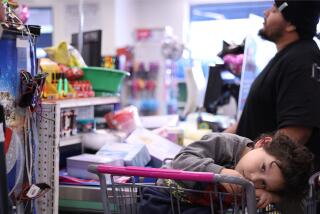ENTERPRISE : LEARNING CURVE: KIP’S TOYLAND : The Right Place : Location Means Longevity for Toy Seller
- Share via
Since Irvin “Kip” Kipper founded Kip’s Toyland in 1945, he’s seen the rise of Toys R Us, Kmart and Wal-Mart, and he learned to adapt by capitalizing on his Farmers Market location and catering to his core customers. Kipper was interviewed by Karen Kaplan.
In 1945, there was no such thing as a year-round toy store. Hardware stores used to put in a toy department in early November and that would last for a couple of months, and department stores would do promotions at Christmastime. But the war was over and people were starting to have families. Suddenly there was a need for someone to specialize in toys, and that’s exactly what I did.
I bought a little store on the corner of 3rd Street and Fairfax [Avenue in Los Angeles] for a little over $2,000.
I remember when we got our first shipment of balloons. They had not been available for many years because all the rubber had gone into the war effort. We blew them up and sold them for 25 cents each, and there was such a line.
In the early years, I had to do considerable scrounging to find enough toys to fill up my store. But in the first 10 years, we were able to move into bigger locations twice. Then the Farmers Market asked if I would like to move my store there. I jumped out of my shoes! The Farmers Market was the “in” place to be. The movie stars used to shop there. They drew people from all over Los Angeles, and it was a tremendous stop for tourists.
When I moved to the Farmers Market, one of the merchants there told me I had just signed an annuity. He said, “You don’t have to worry anymore; you’re in.” The location is so important. That’s why we’re still in business today.
I remember clearly when Sav-On Drugs moved in across the street from us around 1960. People were worried that they might take some of our business because they had a big toy section. It turned out there was no problem.
When I heard about Toys R Us coming in, I was much more worried. I followed the development of Toys R Us with interest. The closest store to us is only three miles away. I wouldn’t be truthful if I said Toys R Us had no impact on our business. People who want a $50 or $60 item will go there because the difference in price between my store and theirs is substantial. On the other hand, if they need a birthday present for the next day, they’ll come into our store and we’ll help them select a gift and wrap it. They can park without any problem, there is no hassle, and they will overlook the fact that perhaps they will pay me $2 more than if they’d gone somewhere else. The customer service is more important.
We’ve eliminated our electronics department entirely because we were unable to compete with the mass merchandisers like Best Buy and Circuit City. The competition was just brutal. We would sell a Nintendo unit for $129.99, but the bigger stores could sell them for less.
Despite the onslaught of competition, our business managed to survive and prosper. There used to be about 40 stores like mine in the area, but now there are only five. We’re just lucky to be in the Farmers Market, where half of our customers are tourists.
On being invited to the Farmers Market . . .
“I jumped out of my shoes! The Farmers Market was the ‘in’ place to be. . . . They drew people from all over Los Angeles, and it was a tremendous stop for tourists.”
On how Toys R Us has affected his store . . .
“I wouldn’t be truthful if I said Toys R Us had no impact on our business. People who want a $50 or $60 item will go there because the difference in price between my store and theirs is substantial.”
On how his business has lasted 50 years . . .
Customers “will overlook the fact that perhaps they will pay me $2 more than if they’d gone somewhere else. The customer service is more important.”
AT A GLANCE
Business: Kip’s Toyland
Owner: Irvin “Kip” Kipper, 79
Nature of business: Toy store
Location: Los Angeles
Number of employees: Six
Annual Sales: About $450,000
More to Read
Inside the business of entertainment
The Wide Shot brings you news, analysis and insights on everything from streaming wars to production — and what it all means for the future.
You may occasionally receive promotional content from the Los Angeles Times.











